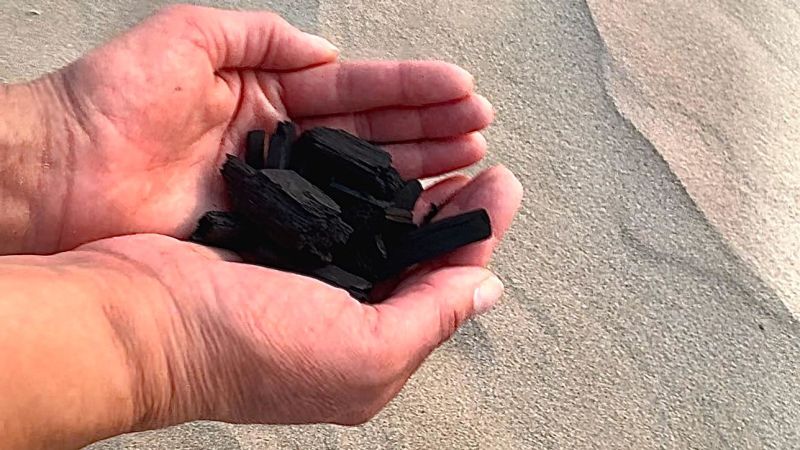CNN
—
It’s hard to green the desert. Take China, or Africa’s Sahel region, for example. Their “Great Green Walls,” grand projects to beat back encroaching desert by planting trees, have required decades of slog, innumerable saplings and billions of dollars – and even then, critics have questioned how sustainable these solutions are.
The United Arab Emirates (UAE) is 80% desert. Only 0.7% of land is arable and it imports more than 90% of its food. Unsurprisingly, the oil-rich nation has proved fertile ground for companies aiming to change those statistics, as the UAE attempts to innovate its way toward food security.
HyveGeo, with operations in Cambridge, England, and in Abu Dhabi, is the latest startup that thinks it has found a way to turn the desert green while turning a profit too.
Using agricultural waste and algae, the company is creating a fertile mixture designed to boost plant growth for tree planting projects and food production, reviving desert and other non-arable land. And through growing algae, it says it can remove climate-warming carbon dioxide from the atmosphere in the process.
“Our model can solve multiple problems at the same time,” explained Dr. Samsurin Welch, HyveGeo chief operations officer and director of research. “There’s a carbon problem, there’s a food security problem, and we can kill two birds with one stone.”
The main ingredient for HyveGeo’s product is biochar, a carbon-rich, charcoal-like material made by burning organic materials in a low-oxygen environment in a process known as pyrolysis.
HyveGeo is sourcing its organic material from local date palm farms and other agricultural waste, and processing it at a pilot site in Abu Dhabi. To date, the site has produced 200 tons of biochar, diverting 800 tons of waste from landfill, said company founder Abdulaziz bin Redha. But those figures could soon be dwarfed by its first commercial facility, scheduled to open in mid-2026 and capable of processing 40,000 tons of biomass per year.
HyveGeo is selling carbon credits against its biochar, allowing companies to offset their carbon footprint. When HyveGeo enters commercial production, it plans to sell its biochar to the agricultural sector, improving soil health while sequestering carbon for hundreds of years
But the material has its limitations. “Biochar itself is fantastic, but if you stick it in desert sand it doesn’t do that much. Desert sand is desert sand; you need to add more to it,” explained Welch.
To green the desert, HyveGeo has turned to microalgae.
Algae absorb atmospheric carbon dioxide and emit oxygen via photosynthesis, and have been doing so since before the first land plants ever existed. Cultivating microalgae for carbon drawdown has taken off in recent years. One company, Brilliant Planet, has proposed growing it on the fringes of the Sahara Desert in Morocco, then burying it. Others have trialled it as a biofuel. A German designer even proposed vitamin and mineral rich microalgae could be the next big thing in high-end gastronomy.
HyveGeo first experimented with turning microalgae into biochar, before realizing it was “like growing saffron and burning it,” according to Redha. Instead, the company now puts microalgae through what it calls a “biorefinery concept,” extracting bioactive compounds. These compounds act as biostimulants or natural fertilizers, and can be added along with beneficial microbes to biochar in different recipes to promote the growth of specific crops. Another, more general-purpose formula, could be used for creating forests or grassland.
“Effectively, what we’re doing is accelerating soil creation from something that could take five years down to just less than a month,” said bin Redha.
According to the UN, at least 100 million hectares of healthy land is lost globally every year through land degradation. To put that figure in context, between 2015 and 2019, that area amounted to roughly double the size of Greenland.
HyveGeo is testing its product on crops including tomatoes. Compared to a control environment, “the plants are bushier, bigger,” said bin Redha, adding that the plants flowered and fruited at higher temperatures than tomatoes regularly permit, and grew outside in temperatures up to 45 degrees Celsius (113 degrees Fahrenheit) – indicators that the growing medium helped combat climate stressors.
HyveGeo’s biochar soil solution is being trialed in partnership with the Abu Dhabi Food and Agricultural Safety Authority and Silal Innovation Oasis, both in the UAE.
Bin Redha said HyveGeo’s product could be used to grow staple crops in the UAE like cowpea, millet, wheat and rice, as well as leafy greens and fruit and vegetables.
Dr. Marcella Fernandes de Souza, a postdoctoral researcher at Ghent University, in Belgium, and an expert in algae biotechnology, who is not involved with HyveGeo, told CNN in an email that “it seems they (HyveGeo) are covering all bases to make the soil arable.
“However,” she continued, “soil dynamics are very complex and it can take some time for the soil to fully regenerate and regain its health, so I do not know what time frame would be realistic to fully recover this soil.”
She also questioned the irrigation requirements for crop cultivation in desert regions.
Producing enough microalgae to meet demand and make HyveGeo’s model commercially viable are just two of many challenges the startup faces.
“It’s really difficult,” bin Redha conceded. “We have seen startups that are very well funded and have been running for 15 years and unfortunately gone into administration (growing microalgae) in the desert.
“It’s about finding a way to grow at scale at a cost-effective way – and I think we’re very, very close to cracking that.”
One positive is the location of HyveGeo’s operation. Dr. de Souza noted that algae farms “need to focus on locations with large available land and good weather and sun irradiation” – three elements the UAE has in abundance.
HyveGeo will announce its next round of venture capital funding this summer, and has entered into partnership with a state-owned company on its commercial biochar processing site.
Long term, Redha says he wants the company to export its model worldwide through licensing deals in places with desert and degenerated land. HyveGeo’s goal is to regenerate 10,000 hectares of land and remove 1 million tons of carbon dioxide from the atmosphere by 2035.
“Climate is a long-term thing and climate is apolitical,” added Welch. “We have a big challenge to solve, and if we can do our bit to solve the problem, that’s a wonderful thing.”

